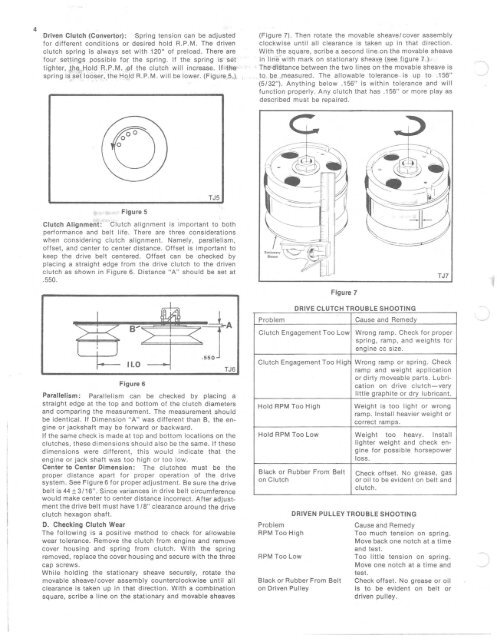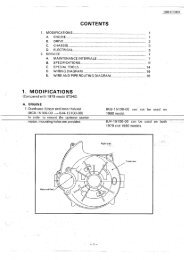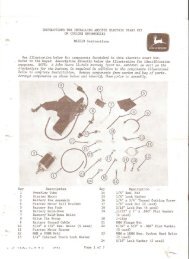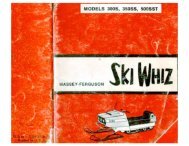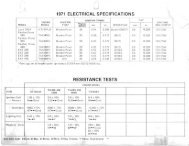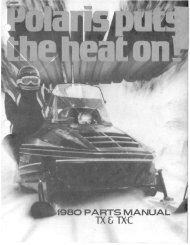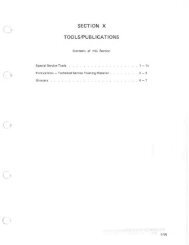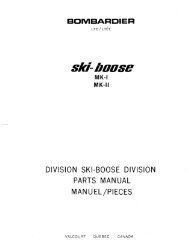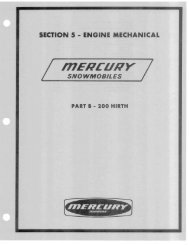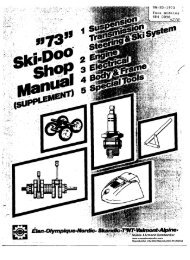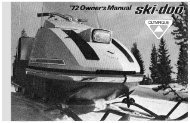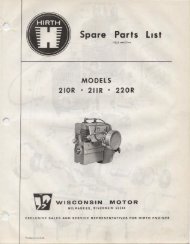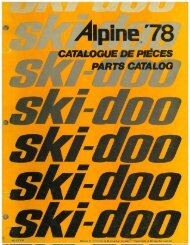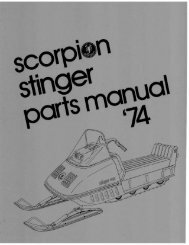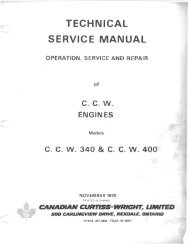1975 Thunderjet - Vintage Snow
1975 Thunderjet - Vintage Snow
1975 Thunderjet - Vintage Snow
You also want an ePaper? Increase the reach of your titles
YUMPU automatically turns print PDFs into web optimized ePapers that Google loves.
4<br />
Driven Clutch (Convertor): Spring tension can be adjusted<br />
for different conditions or desired hold R.P.M. The driven<br />
clutch spring is always set w ith 120 0<br />
of preload. There are<br />
four settings possible for the spring. If the spring is set<br />
tighter, the Hold R.P.M. of the clutch will increase. If the<br />
spring is set loo ser, the Hold R.P.M. will be lower. (Fi gure 5.).<br />
(Figure 7). Then rotate the movable sheavel cover assembly<br />
clockwise until all clearance is taken up in that direction.<br />
With the square, scribe a second line on the movable sheave<br />
in line w ith mark on stationary sheave (see f igure 7.)<br />
The distance between the two lines on the movable sheave is<br />
to be measured. The allowable tolerance is up to .156"<br />
(5/32"). Anything below .156" is within to lerance and will<br />
function properly. Any clutch that has .156" or more playas<br />
described must be repaired .<br />
Figure 5<br />
TJ5<br />
Clutch Alignment: Clutch alignment is important to both<br />
performance and belt life. There are three considerations<br />
when considering clutch alignment. Namely, parallelism ,<br />
offset, and center to center distance. Offset is important to<br />
keep the drive belt centered. Offset can be ch ecked by<br />
placing a st raight edge from the drive clutch to the driven<br />
clutch as shown in Figure 6. Distance "A" should be set at<br />
.550.<br />
Figure 7<br />
TJ7<br />
Problem<br />
DRIVE CLUTCH TROUBLE SHOOTING<br />
Clutch Engagement Too Low<br />
Cause and Remedy<br />
Wrong ramp. Check for proper<br />
spring, ramp, and weights fo r<br />
engine cc size.<br />
Fig ure 6<br />
Parallelism: Parall elism can be checked by plac ing a<br />
stra ight edge at the top and bottom of the clutch di ameters<br />
and comparing the measurement. The measurement should<br />
be identical. If Dimension " A" was different than B, the engine<br />
or jackshaft may be forward or backward.<br />
If the same check is made at top and bottom locations on the<br />
clutches, these dimensions should also be the same. If these<br />
dimensions were different, this would indicate that the<br />
engine or jack shaft was too high or too low .<br />
Cente r to Cen ter Dimension : The clutches must be the<br />
proper distance apart for proper operation of the drive<br />
sy stem. See Fi gure 6 for proper adjustment. Be sure th e drive<br />
belt is 44 ± 3 / 16" . Since variances in drive belt circumference<br />
would make center to center distance incorrect. After ad justment<br />
the drive belt must have 1/8" clearance around th e drive<br />
clutch hexagon shaft .<br />
D. Checking Clutc h Wear<br />
The following is a pos it ive method to check for allowable<br />
wear tolerance. Remove th e clutch from engine and remove<br />
cove r hou sing and spring from clutch. With the spring<br />
removed, repl ace t he cover housing and secure with th e t hree<br />
cap screws.<br />
While hol ding the stat io nary sheave sec urely , ro tate th e<br />
movable sheavel cover assembly counte rcl ockwise until all<br />
c lea rance is ta ken up in t hat d irect io n. With a com bin ati on<br />
square, sc rib e a li ne on th e stat ionary and movable sheaves<br />
Clutch Engagement Too Hig~ Wrong ramp or spring. Check<br />
ramp and weight application<br />
or dirty moveable parts. Lubrication<br />
on drive clutch-very<br />
little graphite or dry lubricant.<br />
Hold RPM Too High<br />
Problem<br />
RPM Too High<br />
RPM Too Low<br />
DRIVEN PULLEY TROU BL E SHOOTING<br />
Black or Rubber From Be lt<br />
on Driven Pulley<br />
Weight is too light or wrong<br />
ramp. Install heavier weight or<br />
correct ramps.<br />
Hold RPM Too Low Weight too heavy. Install<br />
lighter weight and check engine<br />
for possible horsepower<br />
loss.<br />
Black or Rubber From Belt<br />
on Clutch<br />
Check offset. No grease, gas<br />
or oil to be evident on belt and<br />
clutch.<br />
Cause and Remedy<br />
Too much tension on spring.<br />
Move back one notch at a time<br />
and test.<br />
Too little tension on spring.<br />
Move one notch at a time and<br />
test.<br />
Check offset. No gre ase or oil<br />
is to be evident on belt or<br />
driven pulley .<br />
~--~------


